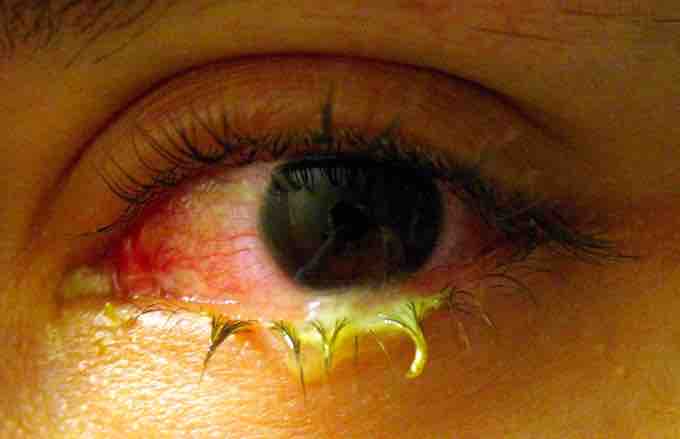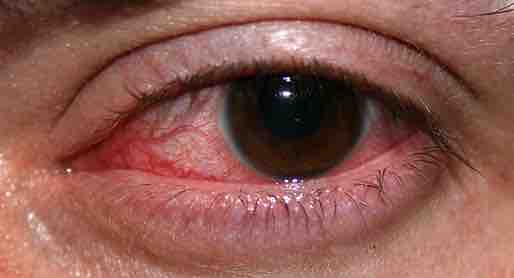Common Eye Infections
CONJUNCTIVITIS
Conjunctivitis, also called pink eye or Madras eye, is inflammation of the conjunctiva, which consists of the outermost layer of the eye and the inner surface of the eyelids. Conjunctivitis most commonly caused by a viral infection or, less commonly, a bacterial infection, or by an allergic reaction. Classification can be either by extent of the inflamed area or by cause (allergic, bacterial, viral or chemical). Neonatal conjunctivitis is often defined separately due to different organisms.
Symptoms and Diagnosis
An inflamed, red eye (hyperaemia), irritation (chemosis), and watering (epiphora) of the eyes are symptoms common to all forms of conjunctivitis. However, the pupils should be normally reactive and the visual acuity normal. Bacterial conjunctivitis due to common pyogenic (pus-producing) bacteria causes marked grittiness/irritation and a stringy, opaque, greyish or yellowish mucopurulent discharge that may cause the lids to stick together, especially after sleep . Another symptom that could be caused by bacterial conjunctivitis is severe crusting of the infected eye and the surrounding skin.

Conjunctivitis
An eye with bacterial conjunctivitis.
Contrary to popular belief, discharge is not essential to the diagnosis. Bacteria such as Chlamydia trachomatis or Moraxella can cause a non-exudative but persistent conjunctivitis without much redness. The gritty and/or scratchy feeling is sometimes localized enough for patients to insist they must have a foreign body in the eye. The more acute pyogenic infections can be painful. Like viral conjunctivitis, it usually affects only one eye but may spread easily to the other eye.
Corynebacterium diphtheriae causes membrane formation in conjunctiva of non immunized children. Bacterial conjunctivitis usually resolves without treatment. Antibiotics, eye drops, or ointment may only be needed if no improvement is observed after three days.
Chlamydiaconjunctivitis or trachoma was once the most important cause of blindness worldwide. The infection can be spread from eye to eye by fingers, shared towels or cloths, coughing and sneezing, and by eye-seeking flies. Newborns can also develop chlamydia eye infection through childbirth. Chlamydia can affect infants by causing spontaneous abortion, premature birth, and conjunctivitis, which may lead to blindness and pneumonia. Conjunctivitis due to chlamydia typically occurs one week after birth (compared with chemical causes (within hours) or gonorrhea (2–5 days)).
KERATITIS
Keratitis is a condition in which the eye's cornea, the front part of the eye, becomes inflamed. The condition is often marked by moderate to intense pain and usually involves impaired eyesight . Superficial keratitis involves the superficial layers (i.e. the epithelium) of the cornea. After healing, this form of keratitis does not generally leave a scar. Deep keratitis involves deeper layers of the cornea (i.e. the epithelium, Bowman's membrane and often stroma), and the natural course leaves a scar upon healing that impairs vision if it occurs on or near the visual axis. This can be reduced or avoided with the use of topical corticosteroid eyedrops.

Keratitis
An eye with non-ulcerative sterile keratitis.
Causes and Treatment
Keratitis has multiple causes. Bacterial infection of the cornea can follow from an injury or from result from wearing contact lenses. The bacteria involved are Staphylococcus aureus and, for contact lens wearers, Pseudomonas aeruginosa. Pseudomonas aeruginosa contains enzymes that can digest the cornea. Treatment depends on the cause of the keratitis. Infectious keratitis can progress rapidly, and generally requires urgent antibacterial, antifungal, or antiviral therapy to eliminate the pathogen. Treatment is usually carried out by an ophthalmologist and can involve prescription eye medications, systemic medication, or even intravenous therapy. It is inadvisable to use over-the-counter eye drops as they are typically not helpful in treating infections; using them could also delay crucial correct treatment, increasing the likelihood of sight-threatening complications. In addition, contact lens wearers are typically advised to discontinue contact lens wear and replace contaminated contact lenses and contact lens cases.